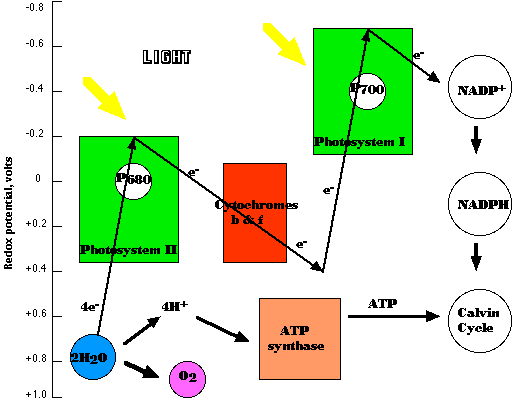Photosynthesis: The Role of Light
The heart of photosynthesis as it occurs in most autotrophs consists of two key processes:
- the removal of hydrogen (H) atoms from water molecules
- the reduction of carbon dioxide (CO2) by these hydrogen atoms to form organic molecules
The second process involves a cyclic series of reactions named (after its discoverer) the Calvin Cycle. It is discussed in Photosynthesis: Pathway of Carbon Fixation.
The details of the first process is our topic here.
The electrons (e-) and protons (H+) that make up hydrogen atoms are stripped away separately from water molecules.
2H2O -> 4e- + 4H+ + O2
The electrons serve two functions:
- They reduce NADP+ to NADPH for use in the Calvin Cycle.
- They set up an electrochemical charge that provides the energy for pumping protons from the stroma of the chloroplast into the interior of the thylakoid.
The protons also serve two functions:
- They participate in the reduction of NADP+ to NADPH.
- As they flow back out from the interior of the thylakoid (by facilitated diffusion), passing down their concentration gradient), the energy they give up is harnessed to the conversion of ADP to ATP.
- Because it is drive by light, this process is called photophosphorylation.
ADP + Pi -> ATP
The ATP provides the second essential ingredient for running the Calvin Cycle.
The removal of electrons from water molecules and their transfer to NADP+ requires energy. The electrons are moving from a redox potential of about +0.82 volt in water to -0.32 volt in NADPH. Thus enough energy must be available to move them against a total potential of 1.14 volts. Where does the needed energy come from? The answer: Light.
The Thylakoid Membrane
Embedded in the thylakoid membrane are 4 different complexes of integral membrane proteins. The exact structure of these complexes differs from group to group (e.g., plant vs. alga) and even within a group (e.g., illuminated in air or underwater). But, in general, one finds:
Photosystem II is a complex of
- 3 identical protein molecules complexed with
- two molecules of the reaction center chlorophyll P680
- some three dozen more molecules of chlorophyll (in plants and green algae, mostly chlorophyll a, some chlorophyll b). Some of these molecules serve as antenna pigments.
- some half dozen carotenoid molecules. These also serve as antenna pigments.
- molecules of pheophytin and plastoquinone
2. Photosystem I
- 3 identical protein molecules
- two molecules of the reaction center chlorophyll P700
- Another complex of the antenna pigments chlorophyll a and b
- a dozen or so carotenoid molecules
4. ATP synthase

How the System Works
- Light is absorbed by the antenna pigments of Photosystems II and I
- The absorbed energy is transferred to the reaction center pigment, P680 in Photosystem II, P700 in Photosystem I
- Activation of P680 removes an electron from it.
- With its resulting positive charge, P680 is sufficiently electronegative that it can remove electrons from water.
- These electrons are transferred (by way of pheophytin and plastoquinone) to the cytochrome b and f complex where they provide the energy for chemiosmosis.
- Activation of P700 enables it to pick up electrons from cytochrome f and raise them to a sufficiently high redox potential that
- they reduce NAD+ to NADPH.
The saw-tooth shifts in redox potential as electrons pass from P680 to NADP+ have caused this system to be called the Z-Scheme.
.gif)
The energy released as electrons pass down the gradient from Photosystem II to Photosystem I is harnessed by the cytochrome b & f complex to pump protons (H+) against their concentration gradient from the stroma of the chloroplast into the interior of the thylakoid (an example of active transport). As their concentration increases inside (which is the same as saying that the pH of the interior decreases), a strong diffusion gradient is set up. The only exit for these protons is through the ATP synthase complex. As in mitochondria, the energy released as these electrons flow down their gradient is harnessed to the synthesis of ATP. The process is called chemiosmosis and is an example of facilitated diffusion.
Chlorophylls a and b differ slightly in the wavelengths of light that they absorb best (although both absorb red and blue much better than yellow and green). Carotenoids help fill in the gap by strongly absorbing green light. The entire complex ensures that most of the energy of light will be trapped and passed on to the reaction center pigments.
16 November 1996

.gif)